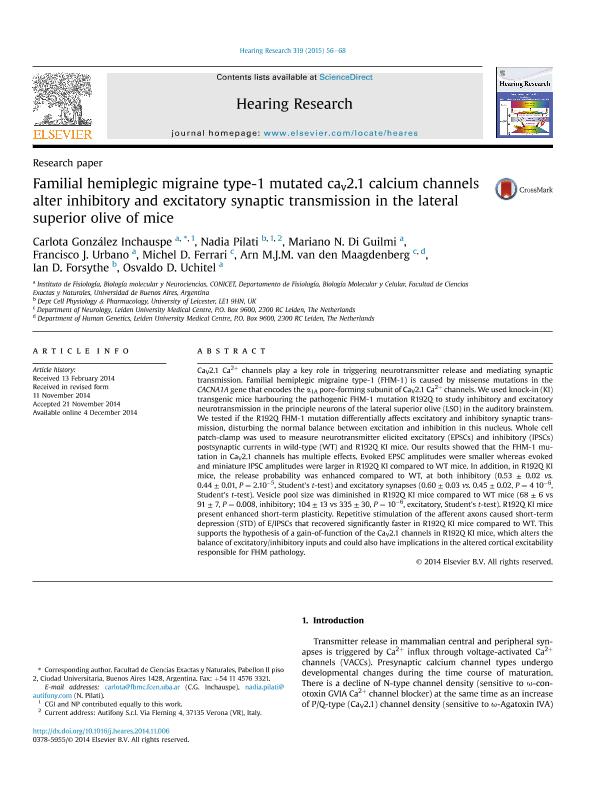Artículo
Familial hemiplegic migraine type-1 mutated cav2.1 calcium channels alter inhibitory and excitatory synaptic transmission in the lateral superior olive of mice
González Inchauspe, Carlota María Fabiola ; Pilati, Nadia; Di Guilmi, Mariano Nicolás
; Pilati, Nadia; Di Guilmi, Mariano Nicolás ; Urbano Suarez, Francisco Jose
; Urbano Suarez, Francisco Jose ; Ferrari, Michel D.; Maagdenberg, Arn M. J. M. van den; Forsythe, Ian D.; Uchitel, Osvaldo Daniel
; Ferrari, Michel D.; Maagdenberg, Arn M. J. M. van den; Forsythe, Ian D.; Uchitel, Osvaldo Daniel
 ; Pilati, Nadia; Di Guilmi, Mariano Nicolás
; Pilati, Nadia; Di Guilmi, Mariano Nicolás ; Urbano Suarez, Francisco Jose
; Urbano Suarez, Francisco Jose ; Ferrari, Michel D.; Maagdenberg, Arn M. J. M. van den; Forsythe, Ian D.; Uchitel, Osvaldo Daniel
; Ferrari, Michel D.; Maagdenberg, Arn M. J. M. van den; Forsythe, Ian D.; Uchitel, Osvaldo Daniel
Fecha de publicación:
01/2015
Editorial:
Elsevier Science
Revista:
Hearing Research
ISSN:
0378-5955
Idioma:
Inglés
Tipo de recurso:
Artículo publicado
Clasificación temática:
Resumen
CaV2.1 Ca2+ channels play a key role in triggering neurotransmitter release and mediating synaptic transmission. Familial hemiplegic migraine type-1 (FHM-1) is caused by missense mutations in the CACNA1A gene that encodes the α1A pore-forming subunit of CaV2.1 Ca2+ channels. We used knock-in (KI) transgenic mice harbouring the pathogenic FHM-1 mutation R192Q to study inhibitory and excitatory neurotransmission in the principle neurons of the lateral superior olive (LSO) in the auditory brainstem. We tested if the R192Q FHM-1 mutation differentially affects excitatory and inhibitory synaptic transmission, disturbing the normal balance between excitation and inhibition in this nucleus. Whole cell patch-clamp was used to measure neurotransmitter elicited excitatory (EPSCs) and inhibitory (IPSCs) postsynaptic currents in wild-type (WT) and R192Q KI mice. Our results showed that the FHM-1 mutation in CaV2.1 channels has multiple effects. Evoked EPSC amplitudes were smaller whereas evoked and miniature IPSC amplitudes were larger in R192Q KI compared to WT mice. In addition, in R192Q KI mice, the release probability was enhanced compared to WT, at both inhibitory (0.53±0.02 vs. 0.44±0.01, P=2.10-5, Student's t-test) and excitatory synapses (0.60±0.03 vs. 0.45±0.02, P=4 10-6, Student's t-test). Vesicle pool size was diminished in R192Q KI mice compared to WT mice (68±6 vs 91±7, P=0.008, inhibitory; 104±13 vs 335±30, P=10-6, excitatory, Student's t-test). R192Q KI mice present enhanced short-term plasticity. Repetitive stimulation of the afferent axons caused short-term depression (STD) of E/IPSCs that recovered significantly faster in R192Q KI mice compared to WT. This supports the hypothesis of a gain-of-function of the CaV2.1 channels in R192Q KI mice, which alters the balance of excitatory/inhibitory inputs and could also have implications in the altered cortical excitability responsible for FHM pathology.
Archivos asociados
Licencia
Identificadores
Colecciones
Articulos(IFIBYNE)
Articulos de INST.DE FISIOL., BIOL.MOLECULAR Y NEUROCIENCIAS
Articulos de INST.DE FISIOL., BIOL.MOLECULAR Y NEUROCIENCIAS
Citación
González Inchauspe, Carlota María Fabiola; Pilati, Nadia; Di Guilmi, Mariano Nicolás; Urbano Suarez, Francisco Jose; Ferrari, Michel D.; et al.; Familial hemiplegic migraine type-1 mutated cav2.1 calcium channels alter inhibitory and excitatory synaptic transmission in the lateral superior olive of mice; Elsevier Science; Hearing Research; 319; 1-2015; 56-68
Compartir
Altmétricas



